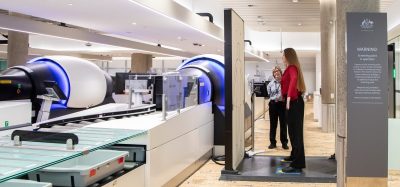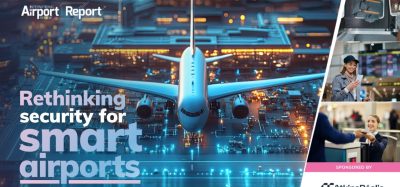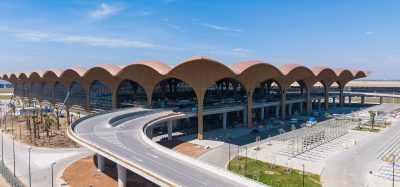Protecting airport infrastructure
Posted: 30 May 2008 | Martin Aggar, Chairman, British Security Industry Association (BSIA) Civil Aviation Section | No comments yet
The requirements of security measures and associated procedures to protect the infrastructure of airports are significant and increasingly important. For, in addition to the airlines and other aviation operators using airports, the travelling public, staff, suppliers, contractors and maintenance companies also need to be included in any protective strategy. This article looks at the application of CCTV and access control systems as part of this strategy.
The requirements of security measures and associated procedures to protect the infrastructure of airports are significant and increasingly important. For, in addition to the airlines and other aviation operators using airports, the travelling public, staff, suppliers, contractors and maintenance companies also need to be included in any protective strategy. This article looks at the application of CCTV and access control systems as part of this strategy.
The car bomb attack on Glasgow international airport’s terminal 1 building in late June 2007, involving a vehicle loaded with propane gas cylinders being set alight, is one demonstration of the dangers involved. In that incident, a miscalculation in the attackers driving prevented the vehicle from fully entering the building and prompt action by staff and airport police helped to quickly contain the situation and prevent it escalating. The presence of CCTV cameras also allowed the attack to be recorded and enabled security forces and the fire brigade to be swiftly directed to the scene, while surveillance camera operators monitored the developing situation. Other than the two bombers themselves, no one was injured.
This dramatic event is just one of the contingencies airport operators must plan for, putting in place systems and operating procedures designed to either deter security breaches from occurring, or deal with them effectively if they do, so that their impact is minimised. The need for an integrated and holistic security strategy is wide ranging, encompassing potential risks that include vandalism and theft, through to environmental protests involving breaches of restricted areas, or terrorist attacks. In addition to the span of targets that an airport contains are the demands posed by the airport’s layout, on what is often a large site area with associated perimeter exposure.
Join us live: Shaping the Next Generation of Hold Baggage and Air Cargo Screening
Join us live for an insightful webinar on 11th December at 14:00 GMT, in collaboration with Smiths Detection, as we explore the strategic balance of operational efficiency, regulatory compliance, and sustainability in high-volume security environments.
This session offers a focused look into future-proofing your security strategy.
Key learning points
- Cost Reduction: Strategies to minimize bag travel time while simultaneously reducing operational costs.
- Regulatory Roadmap: Insights into the next wave of regulatory changes and their impact on future investment decisions.
- Sustainable Systems: Practical approaches to building sustainability into security systems and lowering the total cost of ownership (TCO).
- Scalable Solutions: Real-world examples of scalable systems supporting current airport growth and preparing for tomorrow.
Register now for expert insights, case studies, and actionable strategies on operational efficiency!
Given these challenges, security staff are certainly well-aided by the use of CCTV and access control systems. Surveillance cameras facilitate such wide area monitoring, while access control measures ‘operating at the perimeter’ provide a means of validating a person’s identity and then tracking their onward movements whilst within the airport complex. Vehicles entering the boundary can be checked, recorded and physically controlled using a combination of cameras and moveable roadside bollards or barriers. Besides passengers entering perimeter car parks, automatic number plate recording (ANPR) can be linked to the issue of temporary passes for contractors, with facial recordings centrally stored against these details to provide a record of both the vehicle and its occupants. CCTV can also be used on the vehicles and this extends to aircraft. Areas for coverage should also include cargo-handling facilities for both CCTV and access control. Video smoke detection can operate over existing CCTV systems and is very effective in large voluminous areas such as hangers, warehouses and terminal buildings.
Light on the subject
Supplementary measures are required to ensure the cameras can accurately record this information. For example, in addition to ensuring that the correct camera/lens combination is selected for the prevailing conditions, the equipment should include an appropriate optical zoom capability, along with relevant pan/tilt/zoom functionality.
CCTV systems should also be able to cope with weather conditions, including direct sunlight, as well as being capable of functioning in low light levels during the day and at night. A camera is only as good as the light available and white light illuminators should provide colour corrected illumination matched to the visible spectrum, while for ANPR purposes infrared should be used. Infrared can also illuminate longer distances than comparable power white light.
Turning to CCTV recording, traditional tape-based systems have now largely moved to digital technology for reasons including; clarity of images, ease of use, and the ability to search for material more quickly. For any airports yet to make the transition, there is a new British Standard (BS 8495) governing this area to ensure that digital images are of an appropriate standard to be used as evidence in court. To ensure that any incidents are captured, pre- and post-event recording capability is another essential specification requirement – meaning that a pre-determined time period before and after any incident is captured automatically. For instance, this will allow any detector-activated event to be recorded.
As an associated measure, it is recommended that recorded images are watermarked as part of an end-to-end audit trail process that will demonstrate compliance with court procedures and thereby withstand judicial scrutiny, should the material be needed for prosecution purposes.
IP (Internet Protocol) networks offer an increasingly attractive and cost-effective alternative means of transmitting CCTV camera images for example, by utilising spare bandwidth capacity on existing local or wide area networks (wired or wireless LANs/WANs), internet links, or Ethernet cabling, currently used by IT and phone systems. This ‘added value’ functionality enables cameras to be centrally linked, monitored and recorded, without the need for comparatively expensive and inflexible local recording equipment. Added to this scalability, IP CCTV cameras can also be integrated on the same network/cabling as other IP-based systems, such as intruder alarms and access control. Moreover, the use of IP allows existing analogue cameras to be interfaced with the system, meaning cost-effective use of an existing investment without the need to install replacement cameras. Additional cameras can also be added to the network more cheaply and easily, without the requirement for relatively expensive coaxial (hardwired) cabling or a fibre optic transmission link.
Video analytics
Because of their high profile and wide-ranging requirements, airport security users are in the vanguard of advanced technologies designed to increase the functionality and effectiveness of both CCTV and access control systems. Centred on the use of video analytics, this involves the application of intelligent software and unique human characteristics, in the form of biometrics.
Video analytics development has sped up since homeland security programmes in the US were introduced after 9/11. These systems use software processing algorithms that enable a camera to scan a scene, detect a potential alarm event, filter it for a possible false alarm, and if verified notify a CCTV operator of a potential problem requiring investigation and/or remedial action.
Within an airport terminal for instance, applications for this technology include abandoned baggage detection and congestion detection – ie using scene analysis to provide an alert if a large number of people begin arriving in a particular area. At Schiphol airport in Amsterdam, for example, video analytics are being used to help prevent accidental or malicious intrusion onto runway and hangar areas. ‘Virtual tripwire’ perimeter based applications, essentially an area of the camera-monitored scene that triggers an alarm when that tripwire is breached, are also used there to designate unauthorised areas in each camera’s field of view.
Biometric solutions
The need for high security in more sensitive areas of airports lends itself to the use of biometrics, in conjunction with both surveillance and access control systems. When the UK government introduces the new obligatory ID card scheme for airport workers, these may be able to tie in with access control systems. One of the most common biometric methods is fingerprint reading, though other options include eye retina scanning and voice recognition. Dual protection is enabled when, for example, fingerprint readers work in conjunction with other access control systems. These include the use of PIN keypads, swipe card readers and proximity-based devices using RFID technology.
The operational advantages offered by proximity cards include quick, user-friendly, operation of equipment such as half-height turnstile systems or electromagnetic door locks. Airport workers carrying items, for instance, can pass through easily without fuss. In certain appropriate areas, devices such as optical turnstiles can be deployed. These involve the use of an essentially open gap between two pedestals, governed by a light beam that triggers any breach without the correct authorisation via some form of access control. In other parts of an airport, more relevant security may require the use of full-height turnstiles that enable security staff to regulate entry flow into potentially vulnerable parts of the airport apron.
Visitor management
Day to day operations, at any airport, involve a constant stream of arriving visitors in the form of suppliers, sales representatives, contractors, temporary staff etc. and effective, efficient means of handling them are also provided by BSIA member companies.
Visitor management can represent the hidden weak link in an airport’s protective ‘envelope’, since it represents a potential open front door to would-be thieves, protesters or terrorists. Health and safety legislation, covering visitors on-site, is another reason for implementing the recommended minimum of a paper-based visitor management system. Besides acting as a deterrent, this type of arrangement can also vet visitors who may have attempted to gain entry before and thereby highlight potential security breaches.
A variety of extra features can be exploited through the use of an electronic or computerised visitor management system. For instance, more sophisticated access control measures like this will allow airport staff to email the reception desk with details about the arriving guest, which can then be incorporated on the visitor pass along with a number of additional identification features. These can include a photo, barcode, or biometric information such as a fingerprint, which the system can then use to control the individual’s access to certain parts of the site and restrict their permitted time.
Staff buy-in
With this and other airport security systems, the degree to which the staff operating them find the equipment user-friendly plays an important part in determining how successful these measures will prove in the long-term. If they’re seen to be capable and flexible, rather than ineffectual and obstructive, it is likely that employees will take ‘ownership’ and champion them.
An adaptable security system that proves its worth will pay dividends – not just in terms of reduced theft, vandalism, or related losses, but lower insurance premiums and improved staff morale – with knock-on benefits in terms of reduced sickness leave and higher employee retention rates.
Conclusion
Good security is good for business, and airports using effective protective systems will benefit accordingly. The first step towards that goal involves a risk assessment of existing measures or new areas of the airport. BSIA companies are ready to play their role in helping customers to specify the most appropriate, cost effective and ‘future proof’ measures to meet 21st century demands.
The British Security Industry Association is the trade association covering all aspects of the professional security industry in the UK. Its 570 members provide over 70% of UK security products and services and adhere to strict quality standards. For more information see www.bsia.co.uk, email [email protected] or telephone 0845 389 3889.
About Martin Aggar
Martin Aggar (38) is Chairman of the BSIA Aviation Security section and Managing Director of G4S Aviation Security (UK).
He has been Managing Director of the business since November 2005 and is responsible for around 2,700 staff across 19 UK airports. Prior to that, Martin was Commercial Director, G4S Aviation, Rail & Maritime following the merger of Group 4 and Securicor in July 2004.
Martin has over 12 years’ experience in the security industry and has held a number of senior roles including Strategic Account Manager (Aviation) for ADI until its acquisition by Securicor in 2000. During his time at ADI he was security manager at the British Airways Compass Centre at London’s Heathrow Airport and District Manager for commercial security in Southampton.
He has DfT Aviation Security Levels 1&3 and has completed a number of best practice industry training courses while at ADI/Securicor/G4S. He is also an active participant within the European Aviation Security Association (EASA).
Stay Connected with International Airport Review — Subscribe for Free!
Get exclusive access to the latest airport and aviation industry insights from International Airport Review — tailored to your interests.
✅ Expert-Led Webinars – Gain insights from global aviation leaders
✅ Weekly News & Reports – Airport innovation, thought leadership, and industry trends
✅ Exclusive Industry Insights – Discover cutting-edge technologies shaping the future of air travel
✅ International Airport Summit – Join our flagship event to network with industry leaders and explore the latest advancements
Choose the updates that matter most to you.
Sign up now to stay informed, inspired, and connected — all for free!
Thank you for being part of our aviation community. Let’s keep shaping the future of airports together!


















